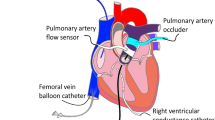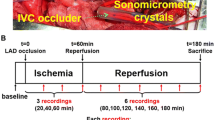Abstract
Objective: Reduced coronary reserve during reperfusion may cause postischemic diastolic dysfunction in pressure-overload-induced hypertrophy. We studied the effect of coronary flow regulation (simulated hyperemic or depressed flow) on postischemic cardiac function during reperfusion.Methods: Left ventricular pressure overload was induced in 4-week-old rats by abdominal aortic constriction. At 6 weeks of age, isolated Langendorff-perfused hearts (perfusion pressures: 75 mmHg in controls and 110 mmHg in the aortic constriction group) were subjected to hypothermic global ischemic (15°C, 210 min), followed by 2 types of coronary flow regulating during the initial 20 min of reperfusion—manipulated high flow in control hearts (group I), manipulated low flow in control hearts (group II), manipulated high flow in aortic constriction hearts (group III), and manipulated low flow in aortic constriction hearts (group IV) (n=6/group), and then constant pressure perfusion during the subsequent 45 min of reperfusion. Cardiac function was measured using an isovolumic balloon in the pre- and postischemic periods.Results: Aortic constriction hearts exhibited greater left ventricular end-diastolic pressure than did control hearts. The increase in left ventricular end-diastolic pressure did not differ between group I (3±2 mmHg) and group II (−1±1 mmHg) or between group III (29±5 mmHg) and group IV (30±6 mmHg). No difference was seen in postischemic recovery of left ventricular systolic pressure between high and low flow groups in control and aortic constriction hearts.Conclusion: Manipulations in coronary flow during reperfusion did not affect postischemic cardiac function in control or aortic constriction hearts, suggesting that depressed coronary flow during early reperfusion is not a primary cause of postischemic diastolic dysfunction in the hypertrophied myocardium.
Similar content being viewed by others
References
Menasche P, Grousset C, Apstein CS, Marotte F, Mouas C, Piwnica A. Increased injury of hypertrophied myocardium cardium with ischemic arrest: preservation with hypothermia and cardioplegia. Am Heart J 1985; 110: 1204–9.
Gaasch WH, Zile MR, Hoshino PK, Weinberg EO, Rhodes DR, Apstein CS. Tolerance of the hypertrophic heart to ischemia: studies in compensated and failing dog hearts with pressure overload hypertrophy. Circulation 1990; 81: 1644–53.
Buser PT, Wikman-Coffelt J, Wu ST, Derugin N, Parmley WW, Higgins CB. Postischemic recovery of mechanical performance and energy metabolism in the presence of left ventricular hypertrophy A 31PMRS study. Circ Res 1990; 66: 735–46.
Anderson PG, Allard MF, Thomas GD, Bishop SP, Digerness SB. Increased ischemic injury but decreased hypoxic injury in hypertrophied rat hearts. Circ Res 1990; 67: 948–59.
Wangler RD, Peters KG, Marcus ML, Tomanek RJ. Effects of duration and severity of arterial hypertension and cardiac hypertrophy on coronary vasodilator reserve. Circ Res 1982; 51: 10–8.
Marcus ML. Effects of cardiac hypertrophy on the coronary circulation. In: Marcus ML, ed. The Coronary Circulation in Health and Disease. New York: McGraw Hill Inc., 1990: 285–306.
Apstein CS, Menasche P, Lorell BH. Hypoxia, ischemia, and the hypertrophied myocardium: basic medical and surgical considerations. In: Swynghedauw B, ed. Cardiac Hypertrophy and Failure. 1st ed. Paris: INSERM/John Libbey Eurotext, 1990: 65–87.
Vatner SF, Shannon R, Hittinger L. Reduced subendocardial coronary reserve. A potential mechanism for impaired diastolic function in the hypertrophied and failing heart. Circulation 1990; 81 (Suppl III):.
Fujii AM, Gelpi RJ, Mirsky I, Vatner SF. Systolic and diastolic dysfunction during atrial pacing in conscious dogs with left ventricular hypertrophy. Circ Res 1988; 62: 462–70.
Snoeckx LHEH, van der Vusse GJ, Reneman RS. The effects of global ischemia and reperfusion on compensated hypertrophied rat hearts. J Mol Cell Cardiol 1990; 22: 1439–52.
Yamamoto H, Avkiran M. Left ventricular pressure overload during postnatal development: effects on coronary vsodilator reserve and tolerance to hypothermic global ischemia. J Thorac Cardiovasc Surg 1993; 105: 120–131.
Yamamoto H, Avkiran M. Changes in coronary vasodilatory reserve induced by pressure overload during post-natal development: effects on post-ischemic perfusion. Eur J Cardiothorac Surg 1993; 7: 26–33.
Curtis MJ, MacLeod BA, Tabrizchi R, Walker MJA. An improved perfusion apparatus for small animal hearts. J Pharmacol Methods 1986; 15: 87–94.
Urdal P, Stromme JH. Effects of Ca, Mg, and EDTA on creatine kinase activity in cerebrospinal fluid. Clin Chem 1979; 25: 147–50.
Aufferman W, Wu ST, Derugin N, Parmley W, Higgins C, Kapelko V, et al. 31P Magnetic resonance spectroscopy of pressure overload hypertrophy in rats: effect of reduced perfusion pressure. Cardiovasc Res 1990; 24: 57–64.
Kloner RA, Ganote CE, Jennings RB. The “no-reflow” phenomenon after temporary coronary occlusion in the dog. J Clinical Invest 1974; 54: 1496–508.
Rakusan K. Microcirculation in the stressed heart. In: Legato, MJ, ed. The Stressed Heart. Boston: Martinus Nijhoff Publishing, 1987: 107–23.
Henquell L, Odoroff CL, Honig CR. Intercapillary distance and capillary reserve in hypertrophied rat hearts beating in situ. Circ Res 1977; 41: 400–8.
Ashruf JF, Ince C, Bruining HA. Regional ischemia in hypertrophic Langendorff-perfused rat hearts. Am J Physiol 1999; 277: H1532–9.
Scholz PM, Grover GJ, Mackenzie JW, Weiss HR. Regional oxygen supply and consumption balance in experimental left ventricular hypertrophy. Basis Res Cardiol 1990; 85: 575–84.
Author information
Authors and Affiliations
Rights and permissions
About this article
Cite this article
Yamamoto, H., Yamamoto, F., Goh, K. et al. Reduced tolerance of global ischemia in the hypertrophied heart. Jpn J Thorac Cardiovasc Surg 49, 287–295 (2001). https://doi.org/10.1007/BF02913135
Received:
Accepted:
Published:
Issue Date:
DOI: https://doi.org/10.1007/BF02913135




